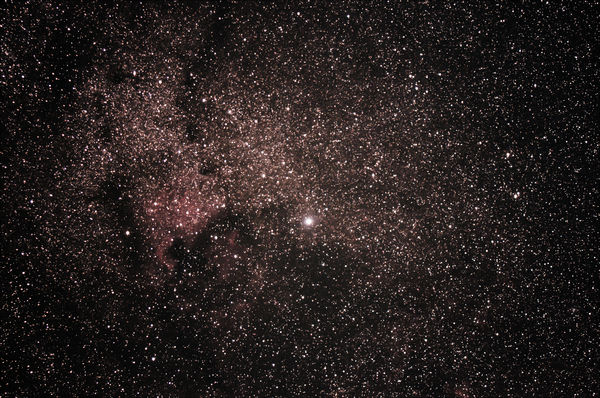A better capture of the "North American Nebula"
Sep 2, 2015 01:49:33 #
Still using the iOpton SkyTracker. This shot was done with a Sony A55 that has been converted to full spectrum which means it captures from visible through near IR. I used no filter. The lens was a Tamron 70-200 and this shot was at 90mm (135mm when considering 1.5x crop), f2.8 for 58 sec (and a total of 4 images were stacked) at ISO 800. The star Deneb is in the center.
The IR ability of this camera is bringing out the redness of the nebula and you can see the shape of North America now. I couldn't see that last night with the unmodified camera.
The iOptron was having no trouble at this focal length with 58 sec images. I did bump it up to 200mm (which is actually 300mm with the crop factor) and I was just starting to see star trails.
The IR capability of this camera brings in far more stars than the shot last night. This one needs to be rotated 90 degrees counter clockwise to match last nights shot also.
The IR ability of this camera is bringing out the redness of the nebula and you can see the shape of North America now. I couldn't see that last night with the unmodified camera.
The iOptron was having no trouble at this focal length with 58 sec images. I did bump it up to 200mm (which is actually 300mm with the crop factor) and I was just starting to see star trails.
The IR capability of this camera brings in far more stars than the shot last night. This one needs to be rotated 90 degrees counter clockwise to match last nights shot also.
Sep 2, 2015 02:50:34 #
Sep 2, 2015 18:42:42 #
Very nice, that's the Pelican Nebula just to the right of the North American Neb.
Sep 2, 2015 18:55:54 #
Algol wrote:
Thank you Jerry. I am just getting started with Nebula and am realizing what a camera that can capture into the IR region can do. I was not seeing this in visible light, but with IR, they are becoming visible.Very nice, that's the Pelican Nebula just to the right of the North American Neb.
And I am surprised how large they are as the lens was set to 90mm (135 if I count crop factor).
I had also noticed a couple months ago that I was seeing more galaxies on IR and when looking them up in StarryNight, the magnitude should have been too low for me to capture. But there they wrre. Tells me the IR magnitude is not always the same as visual magnitude.
I also find in areas like this region of the sky, there are just so many stars that matching them to a specific star in StarryNight is hopeless. Its like picking out a specific grain of sand on the beach.
Sep 4, 2015 06:45:28 #
JimH123 wrote:
Yes, the magnitudes of galaxies (and nebulae, star clusters) are quite often off by several factors. The magnitudes of galaxies are usually photographic (in blue light) and do not usually take into effect the central cores of galaxies which is more times than not redder in coloration (Population I and Population II stars). Most elliptical galaxies are older and so appear redder, spirals on the other hand usually have hot, young blue stars in their arms and older redder stars in their cores or nucleus. What it boils down to is that I would take magnitudes of galaxies with a grain of salt.I had also noticed a couple months ago that I was seeing more galaxies on IR and when looking them up in StarryNight, the magnitude should have been too low for me to capture. But there they were. Tells me the IR magnitude is not always the same as visual magnitude.
I also find in areas like this region of the sky, there are just so many stars that matching them to a specific star in StarryNight is hopeless. Its like picking out a specific grain of sand on the beach.
I also find in areas like this region of the sky, there are just so many stars that matching them to a specific star in StarryNight is hopeless. Its like picking out a specific grain of sand on the beach.
Sep 5, 2015 15:48:52 #
JimH123 wrote:
Still using the iOpton SkyTracker. This shot was ... (show quote)
Beautiful job Jim.
Craig
If you want to reply, then register here. Registration is free and your account is created instantly, so you can post right away.




